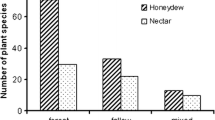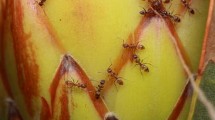Abstract
Ant dominance in tropical ecosystems can be explained by a capacity to exploit liquid foods such as extrafloral nectaries (EFNs) and secretions from honeydew-producing hemipterans (HPHs). Such nutritious exudates may determine ant distribution in space and shape specialization in ant–plant interactions. We provide a first assessment of how EFNs and HPHs mediate the structure of ant assemblages, ant visitation intensity, and characteristics of ant–plant interaction networks across space in Brazilian “cerrado” savanna. We used arboreal pitfall traps to sample visiting ants in four cerrado localities and recorded the presence of lepidopteran larvae to determine their possible response to ant visitation. Ant species composition and richness did not differ regardless of the presence of liquid rewards on plants, and most network patterns did not show consistent differences. However, in two of the four sites, ant densities were higher on plants with HPHs or EFNs due to increased activity by Camponotus and Pseudomyrmex ants. At these two sites, plants with liquid food sources had a more specific ant assemblage (higher specialization d′) than did plants without resources, and caterpillars were more frequently found on plants with fewer workers of Camponotus and Pseudomyrmex. Plants with HPHs had increased ant visitation and accumulated more ant species than did plants with EFNs or without liquid foods. Ant response to such food sources may thus depend on local conditions and identity of ant species, and may determine how ant assemblages are structured. Results highlight how different patterns of ant visitation to liquid resources can produce distinctive effects on herbivore infestation.






Similar content being viewed by others
References
Almeida-Neto M, Ulrich W (2011) A straightforward computational approach for measuring nestedness using quantitative matrices. Environ Model Softw 26:173–178. doi:10.1016/j.envsoft.2010.08.003
Benjamini Y, Hochberg Y (1995) Controlling the false discovery rate—a practical and powerful approach to multiple testing. J R Stat Soc B 57:289–300
Blüthgen N (2010) Why network analysis is often disconnected from community ecology: a critique and an ecologist’s guide. Basic Appl Ecol 11:185–195. doi:10.1016/j.baae.2010.01.001
Blüthgen N, Feldhaar H (2010) Food and shelter: how resources influence ant ecology. In: Lach L, Parr C, Abbott KL (eds) Ant ecology. Oxford University Press, New York, pp 115–136
Blüthgen N, Fiedler K (2004) Preferences for sugars and amino acids and their conditionality in a diverse nectar-feeding ant community. J Anim Ecol 73:155–166
Blüthgen N, Stork NE (2007) Ant mosaics in a tropical rainforest in Australia and elsewhere: a critical review. Austral Ecol 32:93–104. doi:10.1111/j.1442-9993.2007.01744.x
Blüthgen N, Verhaagh M, Goitia W, Jaffe K, Morawetz W, Barthlott W (2000) How plants shape the ant community in the Amazonian rainforest canopy: the key role of extrafloral nectaries and homopteran honeydew. Oecologia 125:229–240
Blüthgen N, Stork NE, Fiedler K (2004) Bottom-up control and co-occurrence in complex communities: honeydew and nectar determine a rainforest ant mosaic. Oikos 106:344–358. doi:10.1111/j.0030-1299.2004.12687.x
Blüthgen N, Menzel F, Blüthgen N (2006) Measuring specialization in species interaction networks. BMC Ecol 6:9. doi:10.1186/1472-6785-6-9
Blüthgen N, Menzel F, Hovestadt T, Fiala B, Bluthgen N (2007) Specialization, constraints, and conflicting interests in mutualistic networks. Curr Biol 17:341–346
Campos R, Camacho G (2014) Ant–plant interactions: the importance of extrafloral nectaries versus hemipteran honeydew on plant defense against herbivores. Arthropod Plant Interact. doi:10.1007/s11829-014-9338-8
Chamberlain SA, Holland JN (2009) Quantitative synthesis of context dependency in ant–plant protection mutualisms. Ecology 90:2384–2392. doi:10.1890/08-1490.1
Dáttilo W, Guimaraes PR, Izzo TJ (2013) Spatial structure of ant–plant mutualistic networks. Oikos 122:1643–1648. doi:10.1111/j.1600-0706.2013.00562.x
Dáttilo W, Marquitti FMD, Guimarães PR, Izzo TJ (2014) The structure of ant–plant ecological networks: is abundance enough? Ecology 95:475–485. doi:10.1890/12-1647.1
Davidson DW (1997) The role of resource imbalances in the evolutionary ecology of tropical arboreal ants. Biol J Linn Soc 61:153–181
Davidson DW, Cook SC, Snelling RR, Chua TH (2003) Explaining the abundance of ants in lowland tropical rainforest canopies. Science 300:969–972
Del-Claro K, Oliveira PS (1999) Ant-Homoptera interactions in a neotropical savanna: the honeydew-producing treehopper, Guayaquila xiphias (Membracidae), and its associated ant fauna on Didymopanax vinosum (Araliaceae). Biotropica 31:135–144. doi:10.1111/j.1744-7429.1999.tb00124.x
Del-Claro K, Oliveira PS (2000) Conditional outcomes in a neotropical treehopper-ant association: temporal and species-specific variation in ant protection and homopteran fecundity. Oecologia 124:156–165
Diaz-Castelazo C, Rico-Gray V, Oliveira PS, Cuautle M (2004) Extrafloral nectary-mediated ant–plant interactions in the coastal vegetation of Veracruz, Mexico: richness, occurrence, seasonality, and ant foraging patterns. Ecoscience 11:472–481
Díaz-Castelazo C, Guimarães PR, Jordano P, Marquis RJ, Rico-Grey V, Thompson JN (2010) Changes of a mutualistic network over time: reanalysis over a 10-year period. Ecology 9:793–801. doi:10.1890/08-1883.1
Dormann CF, Gruber B, Fründ J (2008) Introducing the bipartite package: analysing ecological networks. R News 8:8–11
Dormann CF, Fründ J, Bluthgen N, Gruber B (2009) Indices, graphs and null models: analyzing bipartite ecological networks. Open Ecol J 2:7–24
Freitas AVL, Oliveira PS (1992) Biology and behavior of Eunica bechina (Lepidoptera: Nymphalidae) with special reference to larval defense against ant predation. J Res Lepidoptera 31:1–11
Freitas AVL, Oliveira PS (1996) Ants as selective agents on herbivore biology: effects on the behaviour of a non-myrmecophilous butterfly. J Anim Ecol 65:205–210
González-Teuber M, Heil M (2009) The role of extrafloral nectar amino acids for the preferences of facultative and obligate ant mutualists. J Chem Ecol 35:459–468. doi:10.1007/s10886-009-9618-4
Guimarães PR, Rico-Gray V, Oliveira PS, Izzo TJ, dos Reis SF, Thompson JN (2007) Interaction intimacy affects structure and coevolutionary dynamics in mutualistic networks. Curr Biol 17:1797–1803. doi:10.1016/j.cub.2007.09.059
Hammer Ø, Harper DAT, Ryan PD (2001) PAST: paleontological statistics software package for education and data analysis. Palaeontologia Electronica 1:9
Heil M, McKey D (2003) Protective ant–plant interactions as model systems in ecological and evolutionary research. Annu Rev Ecol Evol Syst 34:425–453
Heil M, Fiala B, Maschwitz U, Linsenmair KE (2001) On benefits of indirect defence: short- and long-term studies of antiherbivore protection via mutualistic ants. Oecologia 126:395–403
Janzen DH (1966) Coevolution of mutualism between ants and acacias in Central America. Evolution 20:249–275
Koptur S (2005) Nectar as Fuel for plant protectors. In: Wackers FL, Van Rijn CJ, Bruin J (eds) Plant-provided food for carnivorous insects: a protective mutualism and its applications. Cambridge University Press, Cambridge, UK, pp 75–108
Koptur S, William P, Olive Z (2010) Ants and plants with extrafloral nectaries in fire successional habitats on Andros (Bahamas). Florida Entomol 93:89–99. doi:10.1653/024.093.0112
Krebs CJ (1989) Ecological methodology. Harper & Row, New York
Lange D, Dáttilo W, Del-Claro K (2013) Influence of extrafloral nectary phenology on ant–plant mutualistic networks in a neotropical savanna. Ecol Entomol 38:463–469. doi:10.1111/een.12036
Leston D (1973) The ant mosaic—tropical tree crops and the limiting of pests and diseases. Trop Pest Manag 19:311–341. doi:10.1080/09670877309412778
Lopes BC (1995) Treehoppers (Homoptera, Membracidae) in southeastern Brazil: use of host plants. Revista Brasileira de Zoologia 12:595–608
Machado SR, Morellato LPC, Sajo MJ, Oliveira PS (2008) Morphological patterns of extrafloral nectaries in woody plant species of the Brazilian cerrado. Plant Biol 10:660–673. doi:10.1111/j.1438-8677.2008.00068.x
Magurran AE (2004) Measuring biological diversity. Oxford: Blackwell Pub. Malden, MA
Majer JD (1990) The abundance and diversity of arboreal ants in Northern Australia. Biotropica 22:191–199
Mody K, Linsenmair KE (2004) Plant-attracted ants affect arthropod community structure but not necessarily herbivory. Ecol Entomol 29:217–225
Oliveira PS, Brandão CRF (1991) The ant community associated with extrafloral nectaries in the Brazilian cerrados. In: Huxley CR, Cutler DF (eds) Ant–plant interactions. Oxford University Press, Oxford, England, pp 198–212
Oliveira PS, Del-Claro K (2005) Multitrophic interactions in a neotropical savanna: ant-hemipteran systems, associated insect herbivores and a host plant. In: Burslem DFRP, Pinard MA, Hartley SA (eds) Biotic interactions in the tropics. Cambridge University Press, Cambridge, pp 414–438
Oliveira PS, Freitas AVL (2004) Ant-plant-herbivore interactions in the neotropical cerrado savanna. Naturwissenschaften 91:557–570. doi:10.1007/s00114-004-0585-x
Oliveira PS, Leitão-Filho HF (1987) Extrafloral nectaries—their taxonomic distribution and abundance in the woody flora of cerrado vegetation in southeast Brazil. Biotropica 19:140–148
Oliveira-Filho AT, Rater JA (2002) Vegetation physiognomies and woody flora of the Cerrado biome. In: Oliveira PS, Marquis RJ (eds) The Cerrados of Brazil: ecology and natural history of a neotropical savanna. Columbia University Press, New York, pp 91–120
Powell S, Costa AN, Lopes CT, Vasconcelos HL (2011) Canopy connectivity and the availability of diverse nesting resources affect species coexistence in arboreal ants. J Anim Ecol 80:352–360. doi:10.1111/j.1365-2656.2010.01779.x
R Development Core Team 2012 (2012) R: a language and environment for statistical computing. In: Team RDC (ed) R 2.15.2. R Foundation for Statistical Computing, Vienna, Austria
Ribas CR, Schoereder JH (2004) Determining factors of arboreal ant mosaics in Cerrado vegetation (Hymenoptera: formicidae). Sociobiology 44:49–68
Ribas CR, Schoereder JH, Pic M, Soares SM (2003) Tree heterogeneity, resource availability, and larger scale processes regulating arboreal ant species richness. Austral Ecol 28:305–314. doi:10.1046/j.1442-9993.2003.01290.x
Rico-Gray V, Oliveira PS (2007) The ecology and evolution of ant-plant interactions. University of Chicago Press, Chicago
Schoereder JH, Sobrinho TG, Madureira MS, Ribas CR, Oliveira PS (2010) The arboreal ant community visiting extrafloral nectaries in the Neotropical cerrado savanna. Terr Arthropod Rev 3:3–27. doi:10.1163/187498310x487785
Sendoya SF, Oliveira PS (2015) Ant-caterpillar antagonism at the community level: interhabitat variation of tritrophic interactions in a neotropical savanna. J Anim Ecol 84:442–452. doi:10.1111/1365-2656.12286
Sendoya SF, Freitas AVL, Oliveira PS (2009) Egg-laying butterflies distinguish predaceous ants by sight. Am Nat 174:134–140. doi:10.1086/599302
Staab M, Blüthgen N, Klein AM (2014) Tree diversity alters the structure of a tri-trophic network in a biodiversity experiment. Oikos. doi:10.1111/oik.01723
Stadler B, Dixon AFG (2005) Ecology and evolution of aphid-ant interactions. Annu Rev Ecol Evol Syst 36:345–372
Styrsky JD, Eubanks MD (2007) Ecological consequences of interactions between ants and honeydew-producing insects. Proc R Soc B Biol Sci 274:151–164
Tobin JE, Huxley CR, Cutler DF (1991) A neotropical rainforest canopy, ant community: some ecological considerations. In: Cutler DF, Huxley CR (eds) Ant–plant interactions. Oxford University Press, Oxford, pp 536–538
Vazquez DP, Bluthgen N, Cagnolo L, Chacoff NP (2009) Uniting pattern and process in plant–animal mutualistic networks: a review. Ann Bot 103:1445–1457. doi:10.1093/Aob/Mcp057
Vazquez DP, Ramos-Jiliberto R, Urbani P, Valdovinos FS (2015) A conceptual framework for studying the strength of plant–animal mutualistic interactions. Ecol Lett 18:385–400. doi:10.1111/ele.12411
Zuur AF, Ieno EN, Walker N, Saveliev AA, Smith GM (2009) Mixed effects models and extensions in ecology with R. Springer, Dordrecht
Acknowledgments
We thank B. Dalsgaard, L. Jorge, M. Pareja, P. I. Prado, and S. Ribeiro for comments on the manuscript. G. Bieber, M. Vidal, A. Moreira, H. Soares, L. Sendoya, M. Pareja, and L. Kaminski helped in the field. A. V. Freitas provided valuable logistic support. We thank the Instituto Florestal do Estado de São Paulo, the Clube Caça e Pesca Itororó, and K. Del-Claro for support during fieldwork in Uberlândia. S.F.S. was sponsored by fellowships from the Fundacão de Amparo à Pesquisa do Estado de São Paulo (FAPESP, 07/59881-5, 12/23399-3). P.S.O. was supported by grants from FAPESP (11/18580-8, 12/23671-5, 14/23141-1), the Brazilian Research Council (CNPq, 306115/2013-1), and the Universidade Estadual de Campinas through Faepex.
Author information
Authors and Affiliations
Corresponding author
Additional information
Handling Editor: Stanislav Gorb.
Electronic supplementary material
Below is the link to the electronic supplementary material.
Rights and permissions
About this article
Cite this article
Sendoya, S.F., Blüthgen, N., Tamashiro, J.Y. et al. Foliage-dwelling ants in a neotropical savanna: effects of plant and insect exudates on ant communities. Arthropod-Plant Interactions 10, 183–195 (2016). https://doi.org/10.1007/s11829-016-9423-2
Received:
Accepted:
Published:
Issue Date:
DOI: https://doi.org/10.1007/s11829-016-9423-2




